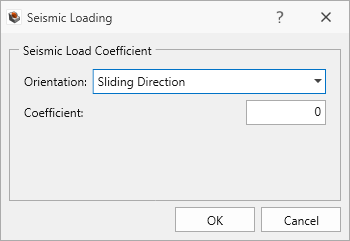Seismic Loading
The Seismic Loading option in the Loading menu allows you to include the effect of pseudo-static earthquake loading in the limit equilibrium analysis.
To define Seismic Load:
- Select the Loading & Support workflow tab

- Select Loading > Seismic Loading

- In the Seismic Loading dialog:
- Set the Orientation. The options for defining the orientation are described below.
- Enter the seismic load Coefficient(s) as described below.
- Click OK.

Orientation
There are three options for defining the Orientation of a pseudo-static Seismic Load:
- Sliding Direction - the direction of applied seismic loading is in the same direction as the sliding direction of the block.
- Trend/Plunge - specify the 3D orientation of a seismic load by entering Trend and Plunge angles.
- Trend is measured in degrees clockwise from the north direction (north = the Y-axis of the model).
- Plunge is measured from the horizontal, with a positive down convention.
- The seismic load Coefficient is applied in the Trend/Plunge direction.
- Vector - specify the 3D orientation of a seismic load in terms of X, Y, Z components. The seismic load coefficient is applied in the Vector direction.
Seismic Coefficient
The seismic Coefficient(s) are dimensionless coefficients which represent the (maximum) earthquake acceleration as a fraction of the acceleration due to gravity. Typical values are in the range of 0.1 to 0.3.
If seismic coefficients are defined, a seismic force will be applied to each block as follows:
Seismic Force = Seismic Coefficient * Block Weight = Seismic Coefficient * Block Volume * Unit Weight of Material
The seismic force is applied through the geometric centroid of each block, according to the selected Orientation method as described above.